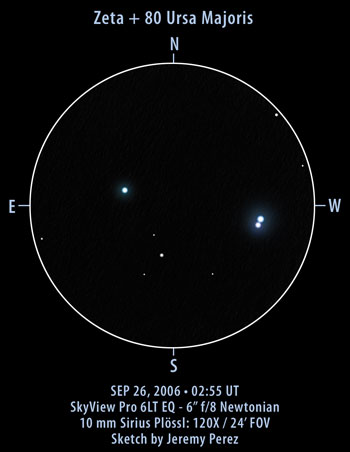

Observation Notes:
The low power (37.5X) view of Mizar and Alcor provides a nice scale of wide and closely spaced doubles mixed with several field stars. The primary of Zeta UMA appeared brilliant blue with what appeared to be a purplish-blue secondary. 80 UMA took on a cyanish blue appearance. The separation between Zeta and 80 UMA was about half the field of my 10 mm eyepiece, or about 720 arc seconds. The actual value is 711 arc seconds. The close double of Zeta UMA, separated by 14.5 arc seconds is also catalogued as Struve 1744.
| Subject | Zeta + 80 Ursae Majoris (STF 1744) |
| Classification | Multiple Star |
| Position (J2000) | Ursa Major [RA: 13:23:55.6 / Dec: +54:55:31]* |
| Position Angle* | AB=153° (1993); AD=72° (1917) |
| Separation* | AB=14.5″ (1993); AD=711.4″ (1917) |
| Magnitudes* | A=2.27; B=3.95; C=4.0 |
| Spectral Types* | A=A1.5V; B=A2; D=A5V |
| Date/Time | SEP 25, 2006 – 7:30 PM MST (SEP 26, 2006 – 02:30 UT) |
| Observing Loc. | Flagstaff, AZ – Home |
| Instrument | Orion SVP 6LT Reflector (150 mm dia./1200 mm F/L) |
| Eyepieces/Mag. | 32 mm (37.5X); 10 mm (120X) |
| Conditions | Partly cloudy, calm |
| Seeing | 5/10 |
| Transparency | NELM Mag 5.8 |
| References | The Washington Visual Double Star Catalog, 1996.0 (Worley+, 1996), Catalogue of Stellar Spectral Classifications (Skiff, 2005), and Visual Double Stars in Hipparcos (Dommanget+, 2000) via VizieR |
*Based on published data.